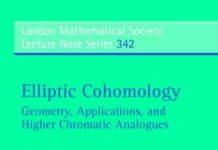
Ebook Info
- Published: 2007
- Number of pages: 380 pages
- Format: PDF
- File Size: 2.04 MB
- Authors: Haynes R. Miller
Description
Edward Witten once said that Elliptic Cohomology was a piece of 21st Century Mathematics that happened to fall into the 20th Century. He also likened our understanding of it to what we know of the topography of an archipelago; the peaks are beautiful and clearly connected to each other, but the exact connections are buried, as yet invisible. This very active subject has connections to algebraic topology, theoretical physics, number theory and algebraic geometry, and all these connections are represented in the sixteen papers in this volume. A variety of distinct perspectives are offered, with topics including equivariant complex elliptic cohomology, the physics of M-theory, the modular characteristics of vertex operator algebras, and higher chromatic analogues of elliptic cohomology. This is the first collection of papers on elliptic cohomology in almost twenty years and gives a broad picture of the state of the art in this important field of mathematics.
User’s Reviews
Editorial Reviews: Book Description First collection of papers on elliptic cohomology in twenty years; represents the diversity of topics within this important field. About the Author Haynes C. Miller is Professor of Mathematics at Massachusetts Institute of Technology, Boston.Douglas C. Ravenel is Fayerweather Professor of Mathematics, University of Rochester, NY.
Reviews from Amazon users which were colected at the time this book was published on the website:
⭐Since its study began in the 1980’s, elliptic cohomology has been viewed as somewhat mysterious by some students and some professional mathematicians and physicists. For the latter class, this is somewhat surprising, given that some of the important ideas in the field have their origin in high-energy physics. This sense of mystery may arise from the manner in which the theory of elliptic cohomology is presented, which from a physicists’ point of view is too abstract and formal. In order to appreciate a particular topic in mathematics, physicists need to have an intuition about the concepts under examination. Elliptic cohomology, along with many other areas of mathematics that are applied to physics, is usually not presented in a way that is makes it readily apparent what is going on behind the scenes.As a whole this book does not grant this type of understanding, but it is still valuable in presenting some of the approaches to giving a geometric understanding of elliptic cohomology in a way that is reminiscent of the ‘classifying space’ approach to the theory of vector bundles. High-energy physicists may find the articles on a conformal field theory of elliptic cohomology and rational vertex operator algebras of great interest, although these articles are very demanding from a mathematical perspective.In the article by Geoffrey Mason on rational vertex operator algebras it is the discussion on the Witt-Grothendieck groups that would have been very interesting if the author would have given more details on this topic. As it stands the reader is left wanting on how these groups (Hermitian K-theory) is connected with conformal field theory. The author does give references for further reading but the article would have been a lot more informative if he would have motivated the subject so that these references can be better appreciated by the curious reader.The article by Graeme Segal entitled “What is an elliptic object” is one that tries to generalize to elliptic cohomology the homotopy-theoretic notion of “representing functor” that gives a classification of vector bundles over a compact space. Interestingly, he does this using concepts from conformal field theory, and does so because of the need for respecting the modularity property of the elliptic genus. If successful, this strategy would give a geometric interpretation to elliptic cohomology, and such an interpretation has been of great interest to both mathematicians and physicists. Because of its dependence on two dimensions, wherein modularity is manifestly apparent (elliptic curves on the upper half plane being the canonical example), (chiral) conformal field theories are thought by Segal and other mathematicians and mathematical physicists as being the proper avenue to such a geometric interpretation. Of particular interest in this article is the notion of a ‘string structure’ on a compact manifold, which occurs when not only the second Stiefel-Whitney class vanishes but also the first Pontryagin class, giving a special spinor bundle on the loop space of the manifold. The author remarks that such a string structure will extend to a conformal field theory of level n over the manifold, but does not show this explicitly. The discussion then turns to the speculations on how this construction could serve as a (geometric) representation for elliptic cohomology. More explicitly, the construction involves taking the tensor product of this theory with the Dirac operator on the loop space of the manifold.The article by D. C. Ravenel on higher chromatic analogs of elliptic cohomology is interesting because of its connection with the theory of topological modular forms (tmf). The latter theory has been given to much discussion in recent years, particularly in connecting elliptic cohomology with the stable homotopy theory of spheres. This application has been concentrated for the most part to fields of characteristic 2 or 3, and as the author remarks the formal group law associated with an elliptic curve cannot have a height greater than 2. To extend to larger periodicities, his strategy is to study the formal completion of the Jacobian of a general Abelian variety of genus g. This object will be a g-dimensional formal group from which one can extract a genus if it has a 1-dimensional summand. The author wants to prove that the Artin-Schreir curve y^e = x^p – x has a Jacobian that has this property, for a prime p and for e = p^f -1 for some positive integer f (the height will then be (p-1)f). He actually gives two proofs, one based on ‘Dieudonne modules’ and the other on ‘Honda matrices’. The latter proof is much more intuitive and will be of value to those readers, such as this reviewer, who are not really acquainted with the Dieudonne theory. The reader can easily work out elementary cases of the Honda matrix approach such as the Fermat curve x^d + y^d = 1 for d = 4 and p = 3 or maybe for d = 5 and p = 3 (genus 6).The essential idea of the author’s approach is to look at particular sets of lattice points and find the orbits of these points under the group action (simply multiplication here). From this one can see that the formal group law for the Jacobian decomposes into a finite number of summands. The Honda matrices are then defined, and after showing a connection between power series expansions of holomorphic 1-forms on the curve and the formal group law for its Jacobian, the author shows that the Honda matrices must satisfy specific types of constraints. These constraints involve the sets of lattice points referred to above (called E in the article). As it turns out, E is the union of its intersection with the orbits under the group action, and this gives a block decomposition for the Honda matrices. The author gives an explicit example for the case where p = 3 and f = 2. This reviewer found it helpful to work out this example alone and then compare it with what the author writes down in the article. These computations are very straightforward to do and helpful to the understanding of the article.
⭐
Keywords
Free Download Elliptic Cohomology: Geometry, Applications, and Higher Chromatic Analogues (London Mathematical Society Lecture Note Series, Series Number 342) in PDF format
Elliptic Cohomology: Geometry, Applications, and Higher Chromatic Analogues (London Mathematical Society Lecture Note Series, Series Number 342) PDF Free Download
Download Elliptic Cohomology: Geometry, Applications, and Higher Chromatic Analogues (London Mathematical Society Lecture Note Series, Series Number 342) 2007 PDF Free
Elliptic Cohomology: Geometry, Applications, and Higher Chromatic Analogues (London Mathematical Society Lecture Note Series, Series Number 342) 2007 PDF Free Download
Download Elliptic Cohomology: Geometry, Applications, and Higher Chromatic Analogues (London Mathematical Society Lecture Note Series, Series Number 342) PDF
Free Download Ebook Elliptic Cohomology: Geometry, Applications, and Higher Chromatic Analogues (London Mathematical Society Lecture Note Series, Series Number 342)


